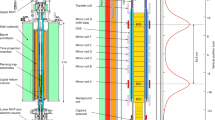Abstract
IN Whitehead's theory of gravitation, as in Einstein's, the tracks of particles in a gravitational field are determined by the condition that a certain integral taken along the track is stationary. The integrand is denoted by dJ in Whitehead's theory and ds in Einstein's. Light-tracks are further conditioned by dJ or ds, respectively, being zero. Since both theories are known to give the observed results for the perihelion of Mercury and the deflexion of light, dJ cannot be widely different from ds in the field of a single particle (the sun); but I do not think it has hitherto been noticed that dJ is exactly equal to ds.
This is a preview of subscription content, access via your institution
Access options
Subscribe to this journal
Receive 51 print issues and online access
$199.00 per year
only $3.90 per issue
Buy this article
- Purchase on SpringerLink
- Instant access to full article PDF
Prices may be subject to local taxes which are calculated during checkout
Similar content being viewed by others
Author information
Authors and Affiliations
Rights and permissions
About this article
Cite this article
EDDINGTON, A. A Comparison of Whitehead's and Einstein's Formulæ. Nature 113, 192 (1924). https://doi.org/10.1038/113192a0
Issue date:
DOI: https://doi.org/10.1038/113192a0
This article is cited by
-
Some new perspectives on the Kruskal–Szekeres extension with applications to photon surfaces
Letters in Mathematical Physics (2024)
-
A unifying physically meaningful relativistic action
Scientific Reports (2022)
-
A family of horizon-penetrating coordinate systems for the Schwarzschild black hole geometry with Cauchy temporal functions
General Relativity and Gravitation (2022)
-
The radial action from probe amplitudes to all orders
Journal of High Energy Physics (2022)
-
Global Regular Null Hypersurfaces in a Perturbed Schwarzschild Black Hole Exterior
Annals of PDE (2022)



